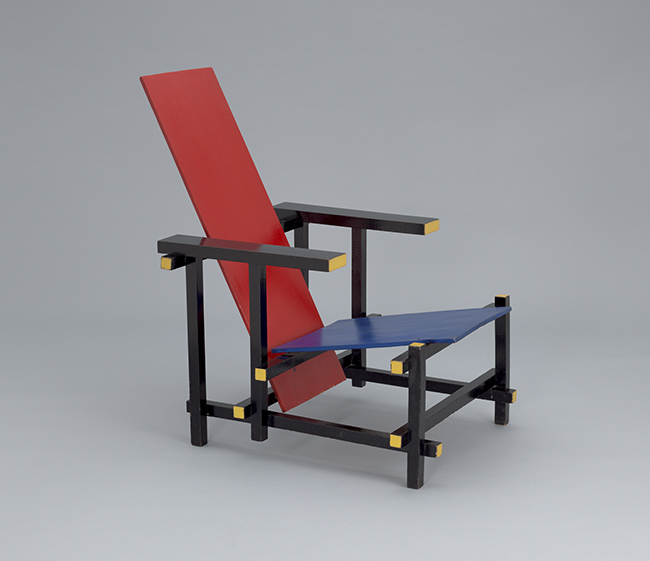Gerrit Rietveld, “Red Blue Chair”
If you are a fan of visual art, you can easily recognize that Rietveld’s Red Blue Chair is closely related to the elements of Mondrian’s painting Composition II with Red Blue and Yellow. Both Rietveld and Mondrian were inspired by De Stijl movement. Gerrit Thomas Rietveld (1888-1964) was a Dutch furniture designer and architect.
The elements of Red Blue Chair consists of thick-black horizontal and vertical lines and primary colors (red, yellow, and blue). All of the lines in this chair meet each other in 90-degree angles. Only the seat and back that is not 90 degrees for the reason of comfortability. All of these structures make the chair looks simple, effective but remain artistically.
Rietveld’s Red Blue Chair is one of the famous icons of De Stijl movement. De Stijl is one of the styles in modern art that emphasizes geometry-shape with horizontal-vertical lines and primary colors. It was promoted by a circle of Dutch abstract artist and founded in 1917 by Piet Mondrian and Theo van Doesburg. De Stijl aims to abstract the essence of life and to express the universal through straight lines and primary colors.
In 1918, Rietvel created the original design Red Blue Chair. The primary colors were just applied in that furniture in 1923. At that time, he hoped that his furniture would be produced in mass-scale, went beyond the handcrafted work. Therefore, he chose simplicity in his design.
Piet Mondrian, “Composition II with Red Blue and Yellow”
It is not surprising that Rietveld’s design attracted the attention of the Bauhaus school in German that one of its aims is to connect creative art and mass-production design. Rietveld’s vision of art was apt to the slogan of the Bauhaus school: “Art into Industry”. In 1923, Walter Gropius, the founder of Bauhaus invited Rietveld to exhibit his works at the Bauhaus.
Furthermore, Rietveld believed that furniture is not only about physical comfort but the well-being or spirit comfort. Along with Mondrian, he believed that art can create a harmonious balance in the world. They also believe that a new form was needed to renew Europe after World War I.
For me, Rietveld’s work still relevant up to now, since his simplicity design inspires the mass-production of furniture today. The topic of art and industry also seems to become an everlasting issue in the art world. In my opinion, the problem is not the encounter of art with industry, but rather the accumulation of capital and profit only on a small group of people.



